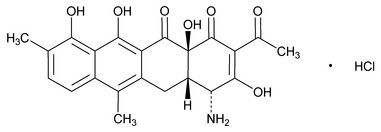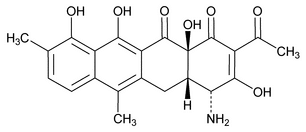The USP (or NF) titles for monograph articles are legally recognized under the Federal Food, Drug, and Cosmetic Act as the designations for use in labeling the articles to which they apply.
The value of designating each drug by one and only one nonproprietary1 name is important in terms of achieving simplicity and uniformity in drug nomenclature. In support of the U.S. Adopted Names program (see Mission and Preface in USP–NF), of which the U.S. Pharmacopeial Convention is a cosponsor, the USP Council of Experts gives consideration to the adoption of the U.S. Adopted Name, if any, as the official title for any compound that attains compendial recognition.
A compilation of the U.S. Adopted Names (USAN) published from the start of the USAN program in 1961, as well as other names for drugs, both current and retrospective, is provided in the USP Dictionary of USAN and International Drug Names. This publication serves as a book of names useful for identifying and distinguishing all kinds of names for drugs, whether public, proprietary, chemical, or code-designated names.2
A nonproprietary name of a drug serves numerous and varied purposes, its principal function being to identify the substance to which it applies by means of a designation that may be used by the professional and lay public free from the restrictions associated with registered trademarks. Teaching in the health sciences requires a common designation, especially for a drug that is available from several sources or is incorporated into a combination drug product; nonproprietary names facilitate communication among healthcare providers; nonproprietary names must be used as the titles of the articles recognized by official drug compendia; a nonproprietary name is essential to the pharmaceutical manufacturer as a means of protecting trademark rights in the brand name for the article concerned; and, finally, the manufacturer is obligated by federal law to include the established nonproprietary name in advertising and labeling.
Under the terms of the Drug Amendments of 1962 to the Federal Food, Drug, and Cosmetic Act, which became law October 10, 1962, the Secretary of Health and Human Services is authorized to designate an official name for any drug wherever deemed “necessary or desirable in the interest of usefulness and simplicity.”3
The Commissioner of Food and Drugs and the Secretary of Health and Human Services published in the Federal Register regulations effective November 26, 1984, which state, in part:
“Sec. 299.4 Established names of drugs.”
“(e) The Food and Drug Administration will not routinely designate official names under section 508 of the act. As a result, the established name under section 502(e) of the act will ordinarily be either the compendial name of the drug or, if there is no compendial name, the common and usual name of the drug. Interested persons, in the absence of the designation by the Food and Drug Administration of an official name, may rely on as the established name for any drug the current compendial name or the USAN adopted name listed in USAN and the USP Dictionary of Drug Names.”4
It will be noted that the monographs on the biologics, which are produced under licenses issued by the Secretary of the U.S. Department of Health and Human Services, represent a special case. Although efforts continue toward achieving uniformity, there may be a difference between the respective title required by federal law and the USP title. Such differences are fewer than in past revisions of the Pharmacopeia. The USP title, where different from the FDA Center for Biologics Evaluation and Research title, does not necessarily constitute a synonym for labeling purposes; the conditions of licensing the biologic concerned require that each such article be designated by the name appearing in the product license issued to the manufacturer. Where a USP title differs from the title in the federal regulations, the former has been adopted with a view to usefulness, simplicity, and conformity with the principles governing the selection of monograph titles generally.
GENERAL NOMENCLATURE FORMS
Some monograph titles existing in the USP–NF do not conform to the formats outlined in this general information chapter. Typically, these monograph titles were adopted before the establishment of the title formats and nomenclature policies presented in this general information chapter. Such monograph titles may be subject to subsequent revision and should not be interpreted as precedents for other monograph titles.
Standardized forms of nomenclature have been devised in the interest of achieving uniformity for naming compendial articles. The general nomenclature forms that follow illustrate the terminology used throughout the official compendia for consistency in establishing titles of monographs on official pharmaceutical dosage forms and preparations. Examples are shown for the more frequently encountered categories of dosage forms.
For a variety of dosage forms, titles are in the following general form: [DRUG] [ROUTE OF ADMINISTRATION] [DOSAGE FORM].
Examples:
Calcium Carbonate Oral Suspension
Cetylpyridinium Chloride Topical Solution
Dexamethasone Ophthalmic Suspension
Epinephrine Bitartrate Ophthalmic Solution
Isosorbide Dinitrate Sublingual Tablets
Miconazole Nitrate Topical Powder
Triple Sulfa Vaginal Cream
The term “Vaginal Inserts”, rather than “Vaginal Tablets”, “Vaginal Capsules”, or “Vaginal Suppositories” is used in the title of this type of vaginal preparation to avoid the potential for misuse of these products if the term “Tablets” or “Capsules” or “Suppositories” were to appear in the title.
Example:
Clotrimazole Vaginal Inserts
The term for route of administration is omitted for those dosage forms for which the route of administration is understood. The general form then becomes simply [DRUG] [DOSAGE FORM]. Thus, capsules, tablets, and lozenges are administered via the oral route unless otherwise indicated by the title.
Examples:
Acetaminophen Capsules
Aminophylline Delayed-Release Tablets
Aspirin Extended-Release Tablets
Hexylresorcinol Lozenges
Meperidine Hydrochloride Tablets
Drugs that are injected may be administered via the intravenous, intramuscular, subcutaneous, etc., route; the route being specified in the labeling rather than in the name.
Examples:
Aurothioglucose Injectable Suspension
Epinephrine Injection
Fluorouracil Injection
Hydrocortisone Acetate Injectable Suspension
Phytonadione Injectable Emulsion
Creams, ointments, lotions, and pastes are applied topically, unless otherwise indicated by the name.
Examples:
Benzoyl Peroxide Lotion
Betamethasone Dipropionate Cream
Estradiol Vaginal Cream
Nystatin Ointment
Zinc Oxide Paste
The term “Suppositories” is used in the titles of preparations that are intended for rectal administration.
Example:
Aspirin Suppositories
The term “for” is included in names, as appropriate, of preparations for which a solid drug substance must be dissolved or suspended in a suitable liquid to obtain a dosage form, and the general form becomes [DRUG] for [ROUTE OF ADMINISTRATION] [DOSAGE FORM].
Examples:
Ampicillin for Oral Suspension
Epinephrine Bitartrate for Ophthalmic Solution
Nafcillin for Injection
Spectinomycin for Injectable Suspension
In some instances, the drug is supplied in one dosage form for the preparation of the intended dosage form.
Examples:
Aspirin Effervescent Tablets for Oral Solution
Methadone Hydrochloride Tablets for Oral Suspension
Papain Tablets for Topical Solution
Systems are preparations of drugs in carrier devices that are applied topically or inserted into body cavities, from which drugs are released gradually over extended times, after which the carrier device is removed. The general form for a system is [DRUG] [ROUTE] [SYSTEM].
Examples:
Nicotine Transdermal System
Progesterone Intrauterine Contraceptive System
Some drugs are available as concentrated solutions that are not intended for direct administration to humans or animals, but are to be diluted with suitable liquid vehicles to obtain the intended preparation. The general form for these preparations, which are not dosage forms, is [DRUG] [CONCENTRATE].
Examples:
Isosorbide Concentrate (used to prepare Isosorbide Oral Solution)
Glutaral Concentrate (used to prepare Glutaral Disinfectant Solution)
For products intended for parenteral administration, the use of the word “Concentrate” in the monograph title is restricted to one specific monograph, Potassium Chloride for Injection Concentrate. The word “Concentrate” should not appear in the monograph title for any other parenteral product; rather, this issue is to be addressed in the product labeling.
Some drugs are supplied as preparations that may be intermediates used for convenience in formulating finished dosage forms. The general form for such preparations, which are not finished dosage forms, is [DRUG] [PREPARATION].
Examples:
Vitamin E Preparation
Cranberry Liquid Preparation
MONOGRAPH NAMING POLICY FOR SALT DRUG SUBSTANCES IN DRUG PRODUCTS AND COMPOUNDED PREPARATIONS
The titles of USP monographs for drug products and compounded preparations formulated with a salt of an acid or base use the name of the active moiety, as defined below. The strength of the product or preparation also is expressed in terms of the active moiety.
An active moiety is the molecule or ion, excluding those appended portions of the molecule that cause the drug to be an ester, salt (including a salt with hydrogen or coordination bonds), or other noncovalent derivative (such as a complex, chelate, or clathrate) of the molecule, responsible for the physiological or pharmacological action of the drug substance, without regard to the actual charged state of the molecule in-vivo.
For example, the active moiety of a hydrochloride salt of a base will be the free base and not the protonated form of the base. The active moiety of a metal acid salt will be the free acid.
i. Example: Chelocardin Hydrochloride active moiety is Chelocardin
ii. Example: Alendronate Sodium active moiety is Alendronic Acid
This Policy is followed by USP in naming drug products and compounded preparations that are newly recognized in the USP. Revising existing monographs to conform to this Policy is not intended, except where the USP Council of Experts determines that, for reasons such as safety, a nomenclature change is warranted.
Related Issues
Labeling—
The labeling clearly states the specific salt form of the active moiety that is present in the product/preparation, as this information may be useful to practitioners and patients. The names and strengths of both the active moiety and specific salt form (where applicable) are provided in the labeling.
Exceptions—
In those rare cases in which the use of the specific salt form of the active moiety in the title provides vital information from a clinical perspective, an exception to this Policy may be considered. In such cases, where the monograph title contains the specific salt form of the active moiety, the strength of the product or preparation also is expressed in terms of the specific salt form.
POLICY FOR POSTPONEMENT SCHEDULES
It is the practice of USP to postpone the official dates of nomenclature and labeling revisions for a reasonable time primarily to allow for product label changes to be made and to allow health practitioners and consumers time to become familiar with the new terminology. A postponement period of 18 months is usually applied when only one or a small number of products is affected. A postponement period of 30 months is usually applied when names or labeling of multisource products or multiproduct lines of a firm's preparations are being changed. A postponement period of 60 months is usually applied for title and labeling changes that affect excipients, because such changes would require relabeling of very large numbers of prescription-only and OTC preparations.
There may be exceptions to this postponement schedule where a shorter time is needed in order to specify nomenclature and labeling changes in cases where public health and safety are a concern.
The assignment of a postponement schedule is handled by the USP Expert Committee on Nomenclature. The postponement schedules are presented below. USP's implementation of a postponement schedule is automatic, unless an exception is sought. Exceptions to the postponement schedule are rarely made, and must have suitable justification as well as the approval of the Expert Committee on Nomenclature. Any questions or concerns regarding this postponement schedule may be addressed to the USP staff liaison assigned to the Expert Committee on Nomenclature.
18 months—Schedule for title and labeling changes for a drug product. One or few companies are involved. Example: Sterile [Drug] change to [Drug] for Injection.
30 months—Schedule for title and labeling changes for prescription-only and OTC products.
- Extensive product line for a company. Examples: syrups and elixirs.
- Several companies are involved. Examples: syrups and elixirs; lotions; sunscreens.
60 months—Schedule for title and labeling changes for excipient monographs. Ingredient names in numerous multisource products are affected.
1
The term “generic” has been widely used in place of the more accurate and descriptive term “nonproprietary” with reference to drug nomenclature.
2
USP Dictionary of USAN and International Drug Names is obtainable on order from U.S. Pharmacopeia, Customer Service Department, 12601 Twinbrook Parkway, Rockville, MD 20852.
3
F.D.&C. Act, Sec. 508 [358].
4
53 Fed. Reg. 5369 (1988) amending 21 CFR § 299.4.
Auxiliary Information—
Please check for your question in the FAQs before contacting USP.
| Topic/Question | Contact | Expert Committee |
|---|---|---|
| General Chapter | Andrzej Wilk, Ph.D.
Senior Scientific Liaison, Nomenclature, Safety, & Labeling 1-301-816-8305 |
(GCPA2010) General Chapters - Physical Analysis |
USP35–NF30 Page 725
Pharmacopeial Forum: Volume No. 35(6) Page 1529



